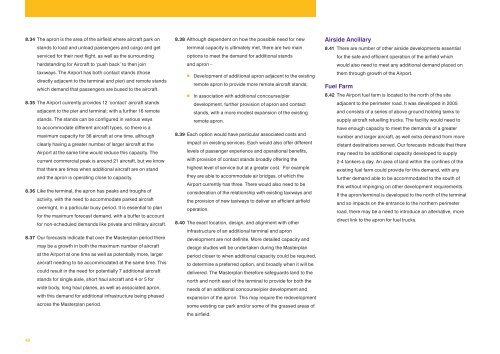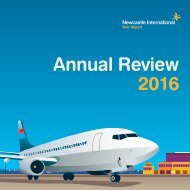Airport Masterplan 2035 LOW RES
You also want an ePaper? Increase the reach of your titles
YUMPU automatically turns print PDFs into web optimized ePapers that Google loves.
<strong>Masterplan</strong> <strong>2035</strong><br />
8.34 The apron is the area of the airfield where aircraft park on<br />
stands to load and unload passengers and cargo and get<br />
serviced for their next flight, as well as the surrounding<br />
hardstanding for Aircraft to ‘push back’ to then join<br />
taxiways. The <strong>Airport</strong> has both contact stands (those<br />
directly adjacent to the terminal and pier) and remote stands<br />
which demand that passengers are bused to the aircraft.<br />
8.35 The <strong>Airport</strong> currently provides 12 ‘contact’ aircraft stands<br />
adjacent to the pier and terminal; with a further 16 remote<br />
stands. The stands can be configured in various ways<br />
to accommodate different aircraft types, so there is a<br />
maximum capacity for 36 aircraft at one time, although<br />
clearly having a greater number of larger aircraft at the<br />
<strong>Airport</strong> at the same time would reduce this capacity. The<br />
current commercial peak is around 21 aircraft, but we know<br />
that there are times when additional aircraft are on stand<br />
and the apron is operating close to capacity.<br />
8.36 Like the terminal, the apron has peaks and troughs of<br />
activity, with the need to accommodate parked aircraft<br />
overnight, in a particular busy period. It is essential to plan<br />
for the maximum forecast demand, with a buffer to account<br />
for non-scheduled demands like private and military aircraft.<br />
8.37 Our forecasts indicate that over the <strong>Masterplan</strong> period there<br />
may be a growth in both the maximum number of aircraft<br />
at the <strong>Airport</strong> at one time as well as potentially more, larger<br />
aircraft needing to be accommodated at the same time. This<br />
could result in the need for potentially 7 additional aircraft<br />
stands for single aisle, short haul aircraft and 4 or 5 for<br />
wide body, long haul planes, as well as associated apron,<br />
with this demand for additional infrastructure being phased<br />
across the <strong>Masterplan</strong> period.<br />
8.38 Although dependent on how the possible need for new<br />
terminal capacity is ultimately met, there are two main<br />
options to meet the demand for additional stands<br />
and apron –<br />
l Development of additional apron adjacent to the existing<br />
remote apron to provide more remote aircraft stands;<br />
l In association with additional concourse/pier<br />
development, further provision of apron and contact<br />
stands, with a more modest expansion of the existing<br />
remote apron.<br />
8.39 Each option would have particular associated costs and<br />
impact on existing services. Each would also offer different<br />
levels of passenger experience and operational benefits,<br />
with provision of contact stands broadly offering the<br />
highest level of service but at a greater cost. For example<br />
they are able to accommodate air bridges, of which the<br />
<strong>Airport</strong> currently has three. There would also need to be<br />
consideration of the relationship with existing taxiways and<br />
the provision of new taxiways to deliver an efficient airfield<br />
operation.<br />
8.40 The exact location, design, and alignment with other<br />
infrastructure of an additional terminal and apron<br />
development are not definite. More detailed capacity and<br />
design studies will be undertaken during the <strong>Masterplan</strong><br />
period closer to when additional capacity could be required,<br />
to determine a preferred option, and broadly when it will be<br />
delivered. The <strong>Masterplan</strong> therefore safeguards land to the<br />
north and north east of the terminal to provide for both the<br />
needs of an additional concourse/pier development and<br />
expansion of the apron. This may require the redevelopment<br />
some existing car park and/or some of the grassed areas of<br />
the airfield.<br />
Airside Ancillary<br />
8.41 There are number of other airside developments essential<br />
for the safe and efficient operation of the airfield which<br />
would also need to meet any additional demand placed on<br />
them through growth of the <strong>Airport</strong>.<br />
Fuel Farm<br />
8.42 The <strong>Airport</strong> fuel farm is located to the north of the site<br />
adjacent to the perimeter road. It was developed in 2005<br />
and consists of a series of above ground holding tanks to<br />
supply aircraft refuelling trucks. The facility would need to<br />
have enough capacity to meet the demands of a greater<br />
number and larger aircraft, as well extra demand from more<br />
distant destinations served. Our forecasts indicate that there<br />
may need to be additional capacity developed to supply<br />
2-4 tankers a day. An area of land within the confines of the<br />
existing fuel farm could provide for this demand, with any<br />
further demand able to be accommodated to the south of<br />
this without impinging on other development requirements.<br />
If the apron/terminal is developed to the north of the terminal<br />
and so impacts on the entrance to the northern perimeter<br />
road, there may be a need to introduce an alternative, more<br />
direct link to the apron for fuel trucks.<br />
42<br />
43




